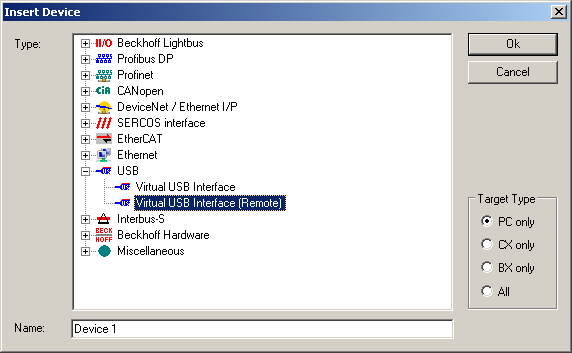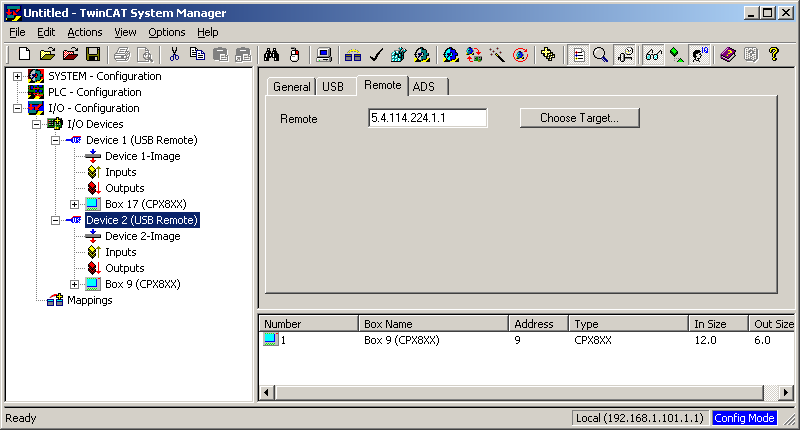Access via "Virtual USB interface (Remote)"
In this case, the CPx8xx Bus Coupler is linked into the client as a local USB device. The CP Link 3 USB device server on the client is configured accordingly via a "Use Local List" (also see Using USB devices locally on the client). The access from host PC to the I/O channels of the Bus Coupler does not then run over the CP Link 3 Virtual USB Hub but rather over ADS directly with the Bus Coupler driver on the client. The advantage here is that less data packets have to be sent over the network connection in each cycle. For this reason, the standard Ethernet timeout of 100 ms is practically never exceeded with this method. Here again, however, it is not possible in theory to exclude the possibility that the time required to send the data packets will become too long. If communication takes place via RT Ethernet the data exchange is carried out deterministically and the outputs cannot release.
"Virtual USB Interface (Remote)" via standard Ethernet
In the TwinCAT System Manager a "Virtual USB Interface (Remote)" device can be inserted into the "I/O Devices" node in the configuration by the selection of "Append Device" in the context menu. The "Virtual USB Interface (Remote)" device can be found underneath the "USB" node in the list of available devices.
After the device has been added the NetID of the target system can be defined on the "Remote" tab. This can either be entered directly or also determined by the "Choose Target" button. When the target system has been reached then connected boxes can be addressed and configured as usual. The recommended cycle time for data exchange with the terminals at the Bus Coupler is still 50 to 80 milliseconds (see also Cycle time for data exchange).
"Virtual USB Interface (Remote)" via RT Ethernet
When an RT Ethernet connection is used for communication with the "Virtual USB Interface (Remote)" the data is exchanged in deterministic cycle times, and this allows the I/O channels of the CPx8xx to be read and written deterministically. The recommended cycle time for data exchange with the terminals at the Bus Coupler is still 50 to 80 milliseconds (see also Cycle time for data exchange).
Setting up RT Ethernet:
- ▪
- A network adapter of both the host PC and the client must be configured as an RT Ethernet device and added to the I/O configuration (also see Configuration of RT Ethernet Devices).
- ▪
- "Routing" must be switched on for this RT Ethernet device on both on the host PC as well as on the client. In addition the NetIds of each of the RT Ethernet devices must be entered respectively in the Routing Tables (also see Configuration of RT Ethernet Devices).
Further configuration is carried out as described in 2.a with the exception that for communication with the "Virtual USB Interface (Remote)" the NetId of the client RT Ethernet device will be added as target system (this differs from the normal NetId).


